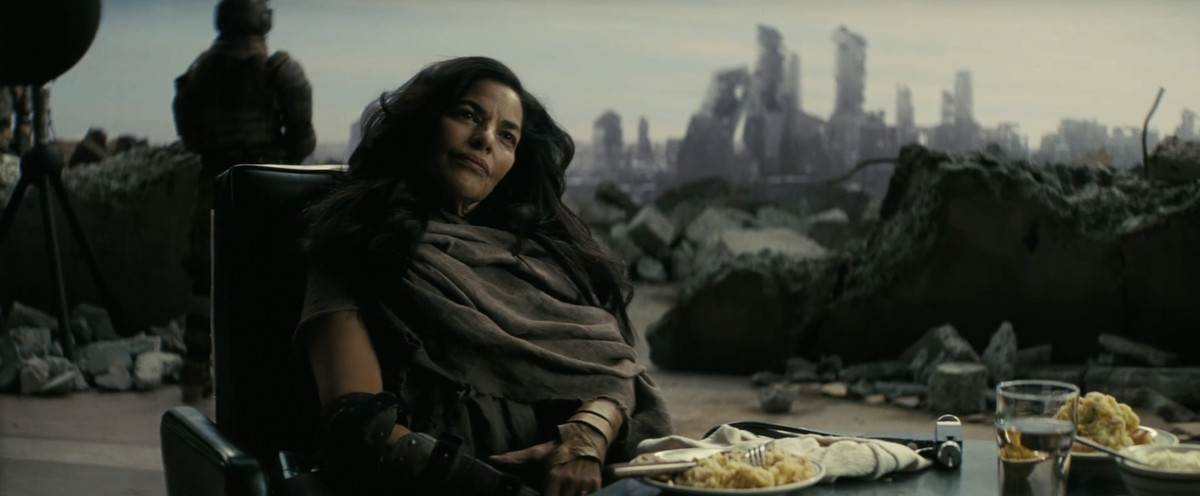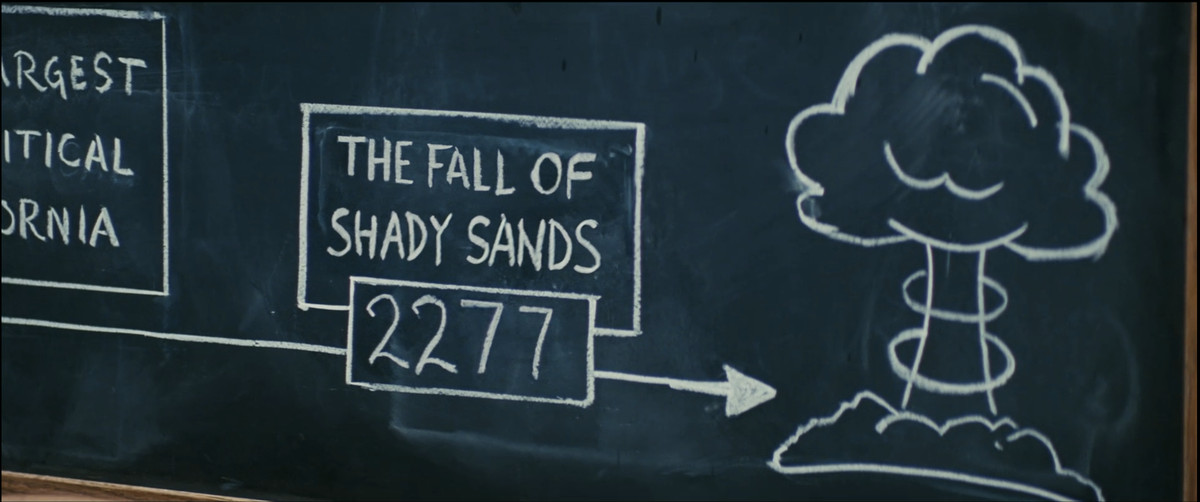Everything Fallout revealed about the NCR
Prime Videos Fallout season 1 delves into the lore of a Vault from the video game source material, including the New California Republic. If you’ve played Fallout games before, you are already aware of the NCR. But if you’re a newcomer to the franchise, the show’s references to the NCR will probably leave you feeling a little lost.
And fair enough too. We don’t get much NCR backstory Fallout season 1, aside from a brief discussion between Maximus (Aaron Moten) and Lucy (Ella Purnell) in episode 5, and a formatted history scribbled on a blackboard, Lucy encounters in episode 6. So if you have any questions about the NCR, the following guide should help fill in the gaps!
(Ed. remark: The following contains spoilers for Fallout season 1.)
What is the Republic of New California?
Image: Primevideo
The NCR is a federation that emerged after the 2077 nuclear war, which left the US in an irradiated hell. It was founded in 2189 in New California – which covers a fair portion of the West Coast and Southwest. As such, the NCR was active for 107 years before Lucy and Maximus visited the ruins of the capital, Shady Sands, in episode 5. According to the episode 6 blackboard, Shady Sands went kablooey in 2277, and the wider NCR subsequently plummeted.
So which states were part of the NCR in its heyday? There were five member states in total (all sharing a border): Dayglow, Hub, Los Angeles, Maxson and Shady. The NCR also has a foothold in parts of Northern California, Oregon and Nevada. As a result, most of the West Coast set Fallout season 1 takes place on (or near) the grounds of the NCR. This also applies to Vault 33, which is located in or near NCR territory.
Who founded the New California Republic?
As established in various Fallout media, the NCR owes its existence to survivors of Vault 15, which – like so many Vaults – gradually became a not-so-fun place to live. These people moved into the Wasteland, founded Shady Sands, and (thanks to the city’s prosperity) slowly made people feel patriotic again. In 2186, a pilot government was formed to work out a constitution, and three years later, voters from Dayglow, Hub, Los Angeles, Maxson, and Shady voted to form the NCR.
Who’s in charge of the Republic of New California?
According to various sources (including radio broadcasts in Fallout 4), the first NCR president was Shady Sands leader Aradesh. When Aradesh disappeared in 2196, his daughter, Tandi, was chosen to replace him. This was the beginning of a form that would make even the most successful real-world politician blush; Tandi won every election she participated in for the next 52 years. It’s also easy to understand why. As recorded in Fallout 2 and several ‘serial Bible’ documents, she transformed the NCR into an economic and political power during Tandi’s half-century of leadership.
But nothing good lasts forever, and Tandi eventually died at the ripe old age of 103. A series of successors followed, none of whom lived up to Tandi’s legacy. Two of them – Fallout: New VegasWendell Peterson and Aaron Kimball have even reversed her progressive policies and (largely) pro-peace stance. As a result, the NCR became embroiled in major problems beginning in the 2250s, including wars with the Brotherhood of Steel and the imperialist slavers Caesar’s Legion.

Image: Primevideo
Kimball is still president of NCR when Shady Sands is reduced to rubble and he is absorbed into the NCR New Vegas — set four years after the destruction of Shady Sands – suggests this is still the case. That said, inside Fallout In the main story of Season 1 from 2296, Moldaver (Sarita Choudhury) is the boss of her own faction of NCR forces. Heck, she’s a quasi-religious figure to the people of Vault 4. Does this mean Moldaver has supplanted Kimball in the intervening years? Maybe.
How technologically advanced is the New California Republic?
Very – through Fallout standards, at least. While the wider Wasteland is effectively an irradiated Wild West, the infrastructure and technology of the NCR, especially in Shady Sands, are much closer to civilization as we know it (or so apparently). Over the years, the NCR has built or repaired power grids (more on that later), roads and railways (we briefly see streetlights and a streetcar in Lucy’s memories of Shady Sands in episode 8).
The NCR is also crushing the country in manufacturing, medical and (especially) agricultural industries. Crucially, the federation has rehabilitated large swathes of agricultural land, giving them ample space for huge herds of Brahmin cows (mutant cows) and crops – with the latter maximized through computer modelling. Collectively, this keeps the NCR’s coffers full.
The NCR military is also nothing to sneeze at. It’s true that they don’t have a stockpile of power armor or other goodies hoarded by the likes of the Brotherhood of Steel, but they still have plenty of firepower. The NCR also knows how to build impressive fortifications, but they don’t rather nuclear weapon proof (just ask anyone who lived in Shady Sands in 2277).
Is the New California Republic really a utopia?
No, even though they try very hard to be. Aside from the NCR’s relatively advanced technology and infrastructure, the federation is a democratic society with courts. These laws include protection for ghouls and other mutants, who are largely second-class citizens in the wider Wasteland. President Tandi also instituted policies to limit the size of Brahmin herds to prevent barons from gaining too much political power.
That all sounds pretty sweet, right? Unfortunately, the NCR is as fallible as any man-made and run institution, and many of its ideals and laws do not always apply in practice. Demons and mutants still experience prejudice in parts of the republic. Moreover, the Brahmin herd was abolished after Tandi’s death, leaving the barons with undue influence, just as the late NCR commander-in-chief feared they would one day do. There is also other evidence of NCR corruption and even quasi-colonialism scattered throughout the Fallout games.
So no, the NCR is not a utopia – even when Shady Sands was at its peak. But it’s still as close to an outright force for good as the Fallout mythos gets.
(Ed. remark: The rest of this post contains spoilers for the end of Fallout season 1 (specifically after episode 5). Only proceed if you want to know some secrets of the Wasteland!)
Whatever happened to the capital of the New California Republic, Shady Sands?

Image: Primevideo
It blew up, literally. As revealed on the other side Fallout season 1, episodes 5 through 8, a nuclear warhead (or something similar) reduced Shady Sands to a crater and several bombed buildings in 2277. This is perhaps the Prime Video show’s biggest contribution to Fallout yet canon, as Shady Sands’ fate is not revealed in any of the games – not even those set after the city’s destruction.
Who gave the order to wipe Shady Sands off the map? Lucy’s father and Vault 33 warden Hank MacLean (Kyle MacLachlan). As Moldaver explains in the season finale, Hank’s wife, Rose, ran away to Shady Sands with little Lucy and her brother Norm in tow. Hank soon tracked them down, and when Rose refused to return to Vault 33, he rounded up the children and destroyed the joint.
What does the Moldaver artifact do?
Another big payout in hand Fallout The season 1 finale finds the show’s mysterious artifact, MacGuffin, being a cold fusion power source. Moldaver developed cold fusion technology as a way to end the energy crisis of her time. However, Vault-Tec bought it and co-opted it – true to form – for decidedly less egalitarian purposes.
So when Moldaver finally gets her hand on the artifact, all she thinks about is using it for its original purpose. And that’s what she does: she uses it to fuel the rest of Shady Sands’ electrical grid. That’s what all those lights are: a symbol of what life could be like in the NCR, not to mention the wider Wasteland, if cold fusion energy were properly harnessed.
How is the New California Republic connected to New Vegas?
The final scene inside Fallout In season 1, a power-armor-clad Hank journeys through the desert to an iconic location from the games: New Vegas. Since Power Armor is only capable of limited short-range flight, even franchise newcomers should quickly find out that New Vegas is not. That far away from Shady Sands. Does this mean the NCR and New Vegas are connected?
In a word: yes. In other words, the NCR and New Vegas signed a treaty in 2274 that (among other things) gives the NCR near-exclusive control over the Hoover Dam – which supplies water and electricity to the member states – as long as the NCR recognizes New Vegas’ sovereignty. . Despite the treaty, the NCR has long harbored hopes of annexing New Vegas, either through diplomacy or military force.
It is currently unclear whether the NCR will ever succeed in absorbing New Vegas. One of the Fallout: New Vegas‘Four headboards show exactly such an annexation, but the other three do not. Current Fallout maintainer Bethesda Game Studios isn’t helping either, remaining coy about which endings are canon. Time and Fallout season 2 – will hopefully set the record straight!
